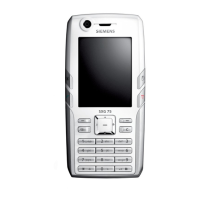Release 1.0
Technical Documentation 01/2006
TD_Repair_L3_SXG75_R1.0.pdf Page 59 of 73
12.1 Microphone, speaker and hands-free speaker
SXG75 contains an internal earpiece receiver, a hands-free/ringer speaker and a microphone. The
microphone and the earpiece receiver are connected to the MSM6250 dedicated audio CODEC
inputs. The hands-free speaker is connected to the output speaker driver of the PM6650 with the
audio signal for the hands-free speaker provided by the auxiliary output of the MSM6250 audio
CODEC. The PM6650 provides an additional series of selectable gain stages which are used to
amplify the speaker output. These are varied with required volume step.
The microphone inputs can pass through an optional secondary gain stage which provides 30dB
gain and additional high pass filtering. This gain stage is specified by the external components
denoted above (C728-C733 & R721-R724). As well as in a call, the microphones are used for voice
dialing, voice memo and the audio component of a video recording.
12.2 Audio accessories
It is possible to connect a mono or stereo headset or car-kit with microphone via the accessory
connector.
The audio output of the accessory connector is provided by the auxiliary output of the MSM6250
audio CODEC which is also used as an audio source for the hands-free speaker. The audio output
to the accessory connector is amplified by an external audio driver (TS4975). This device is
configured using the I2C bus. The address of the device is 0xCC. The external amplifier also
provides variable gain stages controllable over the I2C interface.
The microphone input from the accessories is connected to the second microphone input of the
MSM6250 audio CODEC1.
A variety of wireless headsets and car kits can be used via a Bluetooth link. These bypass the
above codecs and connect directly to the digital encoder and decoder stages of the MSM6250.
13 Cameras
The SXG75 has 2 integrated cameras. A CIF camera (352 x 288) from Agilent is included to support
video conferencing with display of the local user image at a maximum frame rate of 15fps. The
second camera is a 2 Mega pixels sensor primarily for capturing high-resolution still images but
does also support video capture.
13.1 2Mpix camera
The Samsung 2Mega pixel camera module is mounted in socket X1901. The camera is powered
from the VREG_CAM1 (2.85V) supply. This is provided from regulator N1900. The regulator is
enabled when the MSM6250 control line CAM1_PWR_EN is taken high.
The camera is set-up via the I2C bus (I2C_SDA, I2C_SDA). The camera module has a 7-bit address
(1000101). The 8th bit signifies a read or write operation. The I2C bus is an open-drain control, with
pull-up resistors (R905, R906) to VREG_MSMP (2.6V). This bus remains active when the camera is
powered down. This is allowable according to the specifications of the camera. The camera is
supplied with a master clock, CAM1_DSP_CLK, from the dedicated MSM6250 interface.
Company Confidential
2006©BenQ

